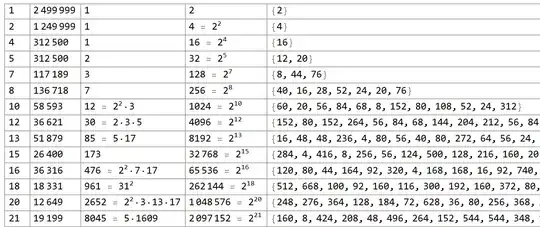Let $f(n)$ give the number of Collatz iterations it takes to yield a number less than $n$, using the "shortcut" version of Collatz which applies $n\rightarrow (3n+1)/2$ for odds.
Suppose it can be shown that $$f(n)=k \iff f(n+a2^k)=k\qquad \forall a\in\mathbb N.$$
So if a starting value of $n$ decreases, it must happen in at most $2^n$ steps, and then we can say the same thing about that lower number, and so on, summing to a worst case upper bound of $2^{n+1}$ steps.
My question: Is my reasoning correct, and if so, is this a known result?
Per request, the reason I think I can show the above is based on the empirical results for $n<5\times 10^6$, which gives:

The leftmost column is $k$, the number of steps required to reach a smaller number. The fourth column, obviously going as $2^k$, is the period after which appearances of $k$ repeat. There are multiple appearances of a given $k$ within that period, e.g. for $k=5$ which shows up with alternating intervals of 12 and 20, but that's not required for my conjecture.
This pattern strikes me as regular enough that I suspect a good reason for it would not be hard to work out. Of course, I could be wrong about that, but my question is whether the rest of my logic makes sense assuming a proper proof for this part exists.
In fact, Wikipedia gives "... it can be shown that the parity sequences for two numbers $m$ and $n$ will agree in the first $k$ terms if and only if $m$ and $n$ are equivalent modulo $2^k$." Parity in this context refers to whether a step increases or decreases the number, so if the parity sequences are the same for two numbers, they will indeed both decrease below their original value on the same step number, which seems like it confirms my suspicion that the above is solid, but as Collag3n points out, is not quite proof.
Couple of thoughts on $f(n)=k \iff f(n+a2^k)=k\qquad \forall a\in\mathbb N$:
First, we still assert that $f(n)=k \implies f(n+a2^k)=k$. Then, let $f(n)=j$ and $f(n+2^k)=k$, where $j \neq k$. Note that $f(n)=j \implies f(n+a2^j)=j$.
If $j<k$, then let $a=2^{k-j}$ and we have $f(n+a2^k)=f(n+(2^{k-j})2^j)=j=f(n+2^k)=k$ by the asserted implication, which is a contradiction.
Experimentally, it looks like $f(n+2^m)>m$ until hitting $f(n+2^k)=k$. Note this would give $f(n+2^k)=k\implies f(n+2^{k-1})>f(n+2^k)$.